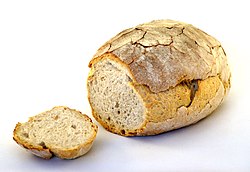
Bread has been a staple food in Switzerland for millennia, probably since the dawn of agriculture. The Swiss Plateau is the main cereal region of the country. [1]
Contents
- Swiss breads
- National breads
- Regional breads
- Sweet breads
- Breads with religious significance
- References
- External links
Nowadays, bread is consumed by almost all Swiss and accompanies practically every meal, making it an integral part of Swiss cuisine. There are several hundred different types of Swiss bread, owing to the diversity of culture and traditions found in the country. [2]
This list includes national, regional and sweet breads.

